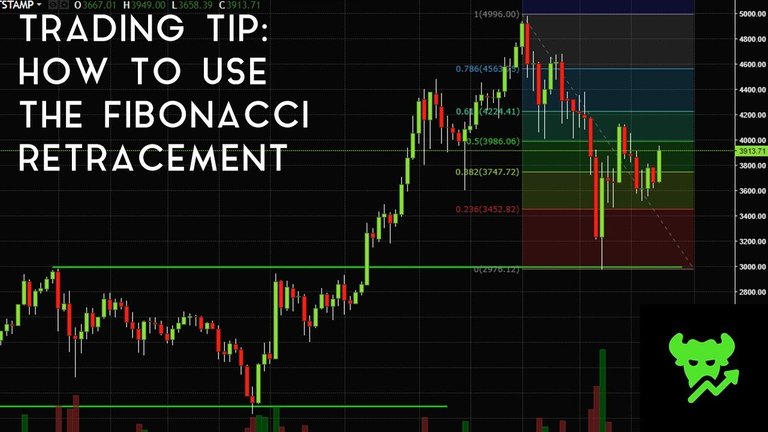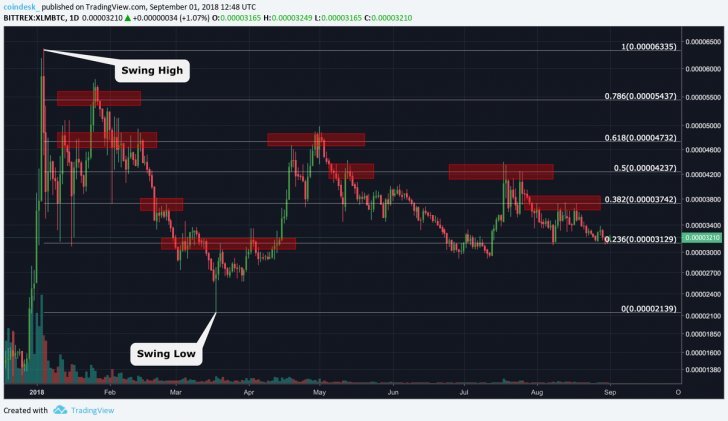Fibonacci retracement. Sounds sophisticated? But what does it do? And does it work? Blog Source: https://www.coindesk.com/crypto-trading-101-the-fibonacci-retracements/
Blog Source: https://www.coindesk.com/crypto-trading-101-the-fibonacci-retracements/
Luckily for traders, Fibonacci retracements are far more than just a nifty word. In fact, it's the name of a tool used to predict potential support and resistance levels for price action.
First, let's define what this so-called "Fibonacci" is so you have a better idea as to why it is a concept relevant to trading cryptocurrencies.
Leonardo of Pisa (A.K.A. Fibonacci) was an 11th-century mathematician responsible for introducing a unique sequence of numbers to the West, now known as the "Fibonacci Sequence."
The Sequence
0, 1, 1, 2, 3, 5, 8, 13, 21, 34, 55, 89, 144, 233, 377, 610, 987, 1597, 2584... (pattern repeats to infinity)
Each number in the sequence is derived from the sum of the preceding two numbers. Clever, right?
Not only that, but each number is roughly 1.618 times greater than the number before it. This creates a value known as the "golden ratio," or "phi" and has a fascinating relationship with nearly everything in nature.
Take flowers, for example, the lily is arranged with three petals, buttercups with five, the chicory with 21, daisies with 34 and so on. Interestingly, the numbers abide by the Fibonacci sequence and each petal is even placed at 0.618 per turn (out of a 360-degree circle), allowing for optimal exposure to sunlight and other factors crucial to survival.
Examples of the Fibonacci sequence in nature are seemingly endless and this expands to trading when it comes to analyzing price action.
Specifically, a trader can derive levels in a trend that price is likely to respect by dividing a peak to trough or trough to peak distance by the golden ratio and other ratios in the sequence. Other important ratios include 0.382 which is any number in the sequence divided by the number two places to its right and 0.236, found by dividing one of the numbers by the one three places to its right.
As you'll come to notice, price reacts to these levels on a regular basis, which can provide a trader with optimal entry and exit points, just like it provides a flower with the optimal structure to absorb sunlight.
Finding Support Levels
Before using the Fibonacci tool to identify potential support or resistance levels, a trader must first be able to identify a "swing high" and "swing low."
A swing high is simply a candlestick at the peak of a trend in any time frame that has a lower high directly to its right and left. Conversely, a swing low is the low candlestick stick of a trend with a higher low on each side.
Once these points are identified, select the Fibonacci retracement tool in your trading software to connect a swing low to a swing high. Potential support levels will be generated, known as retracements.
Each retracement is derived from the vertical "trough to peak" distance divided by ratios in the Fibonacci sequence.

In the above chart, NEO's (NEO/BTC) swing low of 0.001834/BTC was connected to the swing high of 0.015170/BTC on the daily time frame using the Fibonacci retracement tool.
As you can see, the retracements of 0.236, 0.382, 0.5, 0.618, 0.786 were all respected as support, at least temporarily, as price rebounded from its September plunge.
If a trader was to take advantage of this tool from November on, he or she would have had an idea as to where price might land before making its next move, revealing ideal trade entry or exit points.
Finding Resistance Levels
The process to find potential resistance levels is largely the same as before, except this time you will be connecting the swing high to swing low.
The retracements will again appear by dividing the distance from peak to trough using ratios in the Fibonacci sequence.

In the above chart, the anticipated resistance levels for Stellar Lumens (XLM/BTC) were calculated using the Fibonacci tool by connecting the swing high of 0.00006335/BTC to the swing low of 0.00002139.
Once again, price reacted to the levels as advertised.
The 0.786, 0.618, 0.5, and 0.382 retracements all provided resistance on several occasions which would have provided a trader with optimal targets to take profits on his or her position.
Conclusion
It's important to remember that while the Fibonacci tool can be useful in identity supports and resistances, the results are not guaranteed. In order to increase the probability of certain retracements acting as advertised, it is best to use the tool along with other indicators like moving averages or the relative strength index (RSI).
For example, if a moving average is in the same location as a Fibonacci retracement, price is more likely to react to the level given there lie two support or resistance obstacles, which when combined are more powerful than one.
If you went through the sequence calculating each ratio, you may have noticed 0.5 is not one of them yet, it appears as a level in the Fibonacci Retracement tool. Its true, 0.5 is not a ratio in Fibonacci sequence but is included in the tool because it marks a 50 percent trend retracement, which price has a funny way of reacting to as support or resistance.
Disclosure: The author holds BTC, AST, REQ, OMG, FUEL, 1st and AMP at the time of writing.
Golden ratio via Shutterstock; Charts via TradingView
Vote for vote
Please,
Give me Upvote and comments your post link.
I will also do the same too.

Hi! I am a robot. I just upvoted you! I found similar content that readers might be interested in:
https://coinfan.net/2018/09/01/crypto-trading-101-the-fibonacci-retracements/